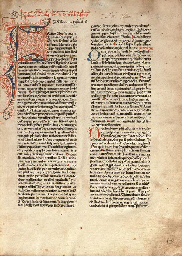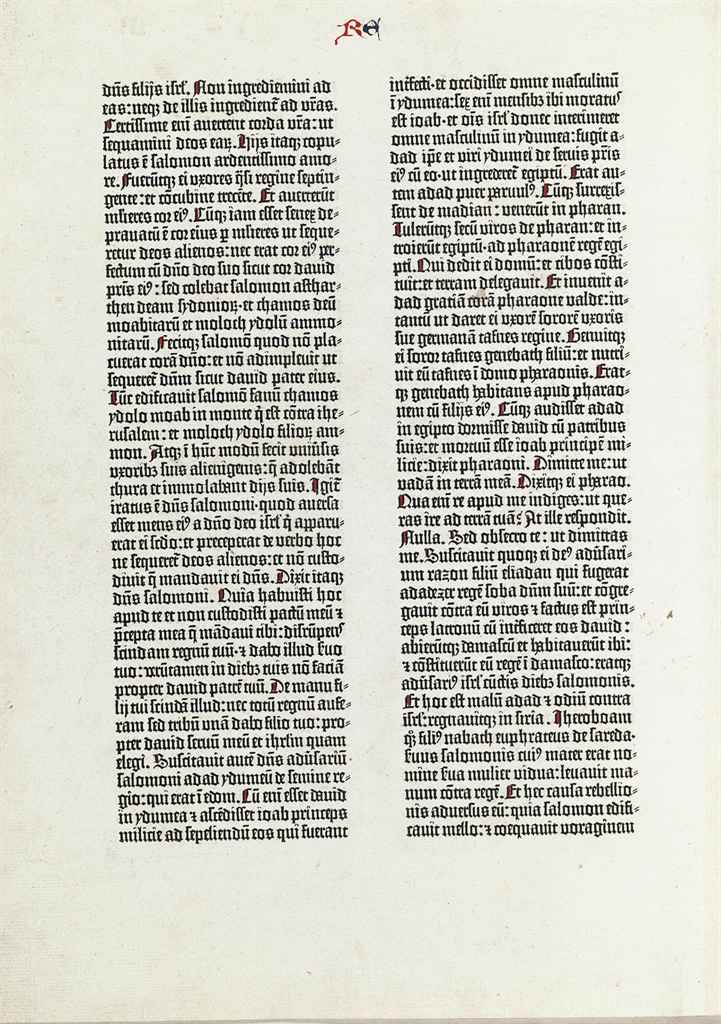BIBLE, LATIN. VOL. I ONLY (Genesis-Psalms). [STRASSBURG: JOHANN MENTELIN, NOT AFTER 1460]. Royal Folio (407 × 295 mm), 215 leaves [a–i12k10l–r12s13], 2 columns- 49 lines, Proctor type 1. Rubricated, fi rst folio illuminated in the XIXth century for Heinrich Klemm, blue blind-tooled shagreen on wooden boards in a retrospective design, metal center and corner-pieces, 2 clasps, untrimmed edges, title and date 1458 gilt on the spine (German binding for Heinrich Klemm, c 1880) THE FIRST BOOK PRINTED IN STRASSBURG and THE FIRST BOOK PRINTED OUTSIDE OF MAINZ: THE ONLY KNOWN COPY IN PRIVATE HAND. THE MENTELIN LATIN BIBLE IS THE SECOND PRINTED BIBLE AFTER THE GUTENBERG BIBLE, AND THE FIRST PRINTED BOOK ON TODAY’S FRENCH TERRITORY. The 1460 Latin Bible is the fi rst book printed by Johann Mentelin (c. 1410–1478), Strassburg’s fi rst printer and fi rst known printer outside of Mainz. The proof-sheets copy (Vol. I alone) preserved in Cambridge has been thoroughly studied by Paul Needham (“The Cambridge Proof Sheets of Mentelin’s Latin Bible”, in Transactions of the Cambridge Bibliographical Society 9, 1986, pp. 1-35), and our description owes a lot to his discoveries. Like most Mentelin’s books, the B-49 was published without a date, but the copy in Fribourg bears rubrication inscriptions: «Explicit psalterium. 1460» (vol. I) and «Explicit apocalipsis Anno domini M°. cccc°.lxi°» (vol. II). As both volumes were printed together, printing was fi nished in 1460: «The traditional priority over the Mentelin Bible accorded to the 36-line Bible, almost certainly printed in Bamberg rather than Mainz, is ungrounded. The rubrication date of 1460 in vol. I of the Freiburg copy of Mentelin’s Bible establishes that the entire edition was completed by that date, for volumes I-II were printed concurrently. The earliest reliable date associated with the 36-line Bible is 1461, the rubrication date of the Wolfenbüttel copy» (P. Needham). The 1460 Latin Bible is a Royal folio of 427 leaves (215 leaves for vol. I, with 215v blank, and 212 leaves for vol. II - absent in the Burrus copy). The 851 printed pages were set in two columns of 49 lines, printed with a single type, Mentelin’s type 1. This attractive semi-gothic type, inspired by the distinctive hand found in the XVth century Alsatian manuscripts, testifi es of Mentelin’s capacities as a scribe. Worn out after printing a large folio Bible, it had to be replaced. It is only found in this book, except for the 1461 indulgence letter recently discovered (Günter Hägele, «Ein unbekannter Mentelin- Druck von 1461 im Stadtarchiv Baden im Aargau», in Gutenberg-Jahrbuch, Bd. 89, 2014, pp. 68-85). The 1460 Bible “was printed on a single stock of Royal paper, watermarked with Bull’s Head. This stock is the same as that found in the 1460 Mainz Catholicon (Goff B-20) – or rather in paper copies of the fi rst printing of the Catholicon…The mill providing both Mentelin and Gutenberg with this paper was located in the Piedmont, near Turin. Earlier the same mill had supplied the chief stocks of the Gutenberg Bible, and later it supplied most or all of the paper of Fust and Schöffer’s 1462 Vulgate (Goff B-259), and of Mentelin’s second book, Aquinas Summa theological II (Goff T-208)” (P. Needham). “We are fortunate in that, although Mentelin’s exemplar has not been identifi ed, we know what it was: a copy of the Gutenberg Bible, entirely of the fi rst setting and apparently without substantial manuscript corrections”. The study of Cambridge proofs shows that “in general the correction was careful…It is clear enough that correction consisted of collating the proof against the exemplar” (P. Needham). “ The most interesting aspect of the Cambridge proofs …the cyclical pattern of their paper stocks” shows that composition proceeded sequentially, in textual order, from the fi rst page of a quire to the last. As for the Gutenberg Bible, composition was divided in 4 units, 2 in each volume. In Vol. I, the two groups of
BIBLE, LATIN. VOL. I ONLY (Genesis-Psalms). [STRASSBURG: JOHANN MENTELIN, NOT AFTER 1460]. Royal Folio (407 × 295 mm), 215 leaves [a–i12k10l–r12s13], 2 columns- 49 lines, Proctor type 1. Rubricated, fi rst folio illuminated in the XIXth century for Heinrich Klemm, blue blind-tooled shagreen on wooden boards in a retrospective design, metal center and corner-pieces, 2 clasps, untrimmed edges, title and date 1458 gilt on the spine (German binding for Heinrich Klemm, c 1880) THE FIRST BOOK PRINTED IN STRASSBURG and THE FIRST BOOK PRINTED OUTSIDE OF MAINZ: THE ONLY KNOWN COPY IN PRIVATE HAND. THE MENTELIN LATIN BIBLE IS THE SECOND PRINTED BIBLE AFTER THE GUTENBERG BIBLE, AND THE FIRST PRINTED BOOK ON TODAY’S FRENCH TERRITORY. The 1460 Latin Bible is the fi rst book printed by Johann Mentelin (c. 1410–1478), Strassburg’s fi rst printer and fi rst known printer outside of Mainz. The proof-sheets copy (Vol. I alone) preserved in Cambridge has been thoroughly studied by Paul Needham (“The Cambridge Proof Sheets of Mentelin’s Latin Bible”, in Transactions of the Cambridge Bibliographical Society 9, 1986, pp. 1-35), and our description owes a lot to his discoveries. Like most Mentelin’s books, the B-49 was published without a date, but the copy in Fribourg bears rubrication inscriptions: «Explicit psalterium. 1460» (vol. I) and «Explicit apocalipsis Anno domini M°. cccc°.lxi°» (vol. II). As both volumes were printed together, printing was fi nished in 1460: «The traditional priority over the Mentelin Bible accorded to the 36-line Bible, almost certainly printed in Bamberg rather than Mainz, is ungrounded. The rubrication date of 1460 in vol. I of the Freiburg copy of Mentelin’s Bible establishes that the entire edition was completed by that date, for volumes I-II were printed concurrently. The earliest reliable date associated with the 36-line Bible is 1461, the rubrication date of the Wolfenbüttel copy» (P. Needham). The 1460 Latin Bible is a Royal folio of 427 leaves (215 leaves for vol. I, with 215v blank, and 212 leaves for vol. II - absent in the Burrus copy). The 851 printed pages were set in two columns of 49 lines, printed with a single type, Mentelin’s type 1. This attractive semi-gothic type, inspired by the distinctive hand found in the XVth century Alsatian manuscripts, testifi es of Mentelin’s capacities as a scribe. Worn out after printing a large folio Bible, it had to be replaced. It is only found in this book, except for the 1461 indulgence letter recently discovered (Günter Hägele, «Ein unbekannter Mentelin- Druck von 1461 im Stadtarchiv Baden im Aargau», in Gutenberg-Jahrbuch, Bd. 89, 2014, pp. 68-85). The 1460 Bible “was printed on a single stock of Royal paper, watermarked with Bull’s Head. This stock is the same as that found in the 1460 Mainz Catholicon (Goff B-20) – or rather in paper copies of the fi rst printing of the Catholicon…The mill providing both Mentelin and Gutenberg with this paper was located in the Piedmont, near Turin. Earlier the same mill had supplied the chief stocks of the Gutenberg Bible, and later it supplied most or all of the paper of Fust and Schöffer’s 1462 Vulgate (Goff B-259), and of Mentelin’s second book, Aquinas Summa theological II (Goff T-208)” (P. Needham). “We are fortunate in that, although Mentelin’s exemplar has not been identifi ed, we know what it was: a copy of the Gutenberg Bible, entirely of the fi rst setting and apparently without substantial manuscript corrections”. The study of Cambridge proofs shows that “in general the correction was careful…It is clear enough that correction consisted of collating the proof against the exemplar” (P. Needham). “ The most interesting aspect of the Cambridge proofs …the cyclical pattern of their paper stocks” shows that composition proceeded sequentially, in textual order, from the fi rst page of a quire to the last. As for the Gutenberg Bible, composition was divided in 4 units, 2 in each volume. In Vol. I, the two groups of










.jpg)




Testen Sie LotSearch und seine Premium-Features 7 Tage - ohne Kosten!
Lassen Sie sich automatisch über neue Objekte in kommenden Auktionen benachrichtigen.
Suchauftrag anlegen